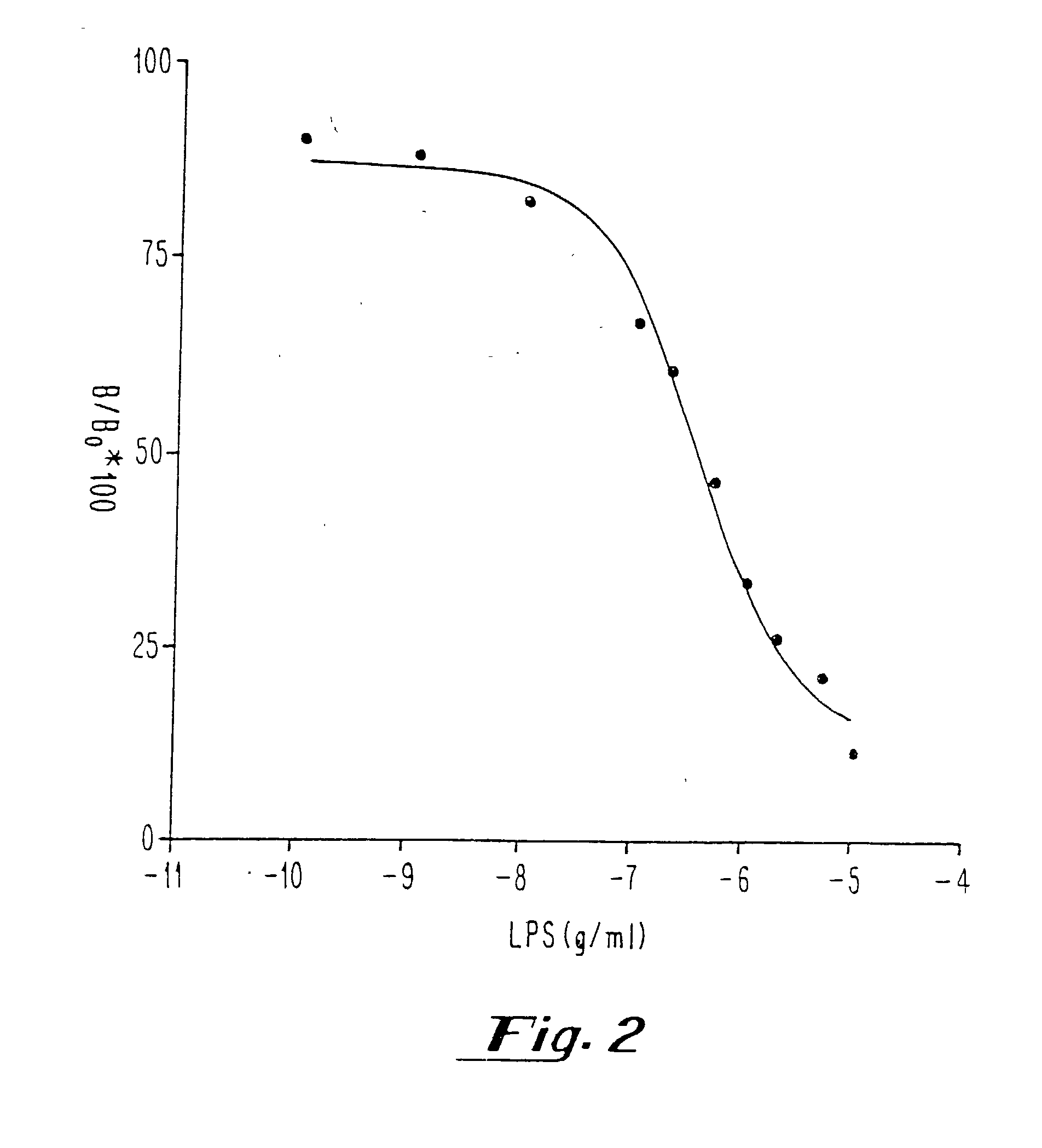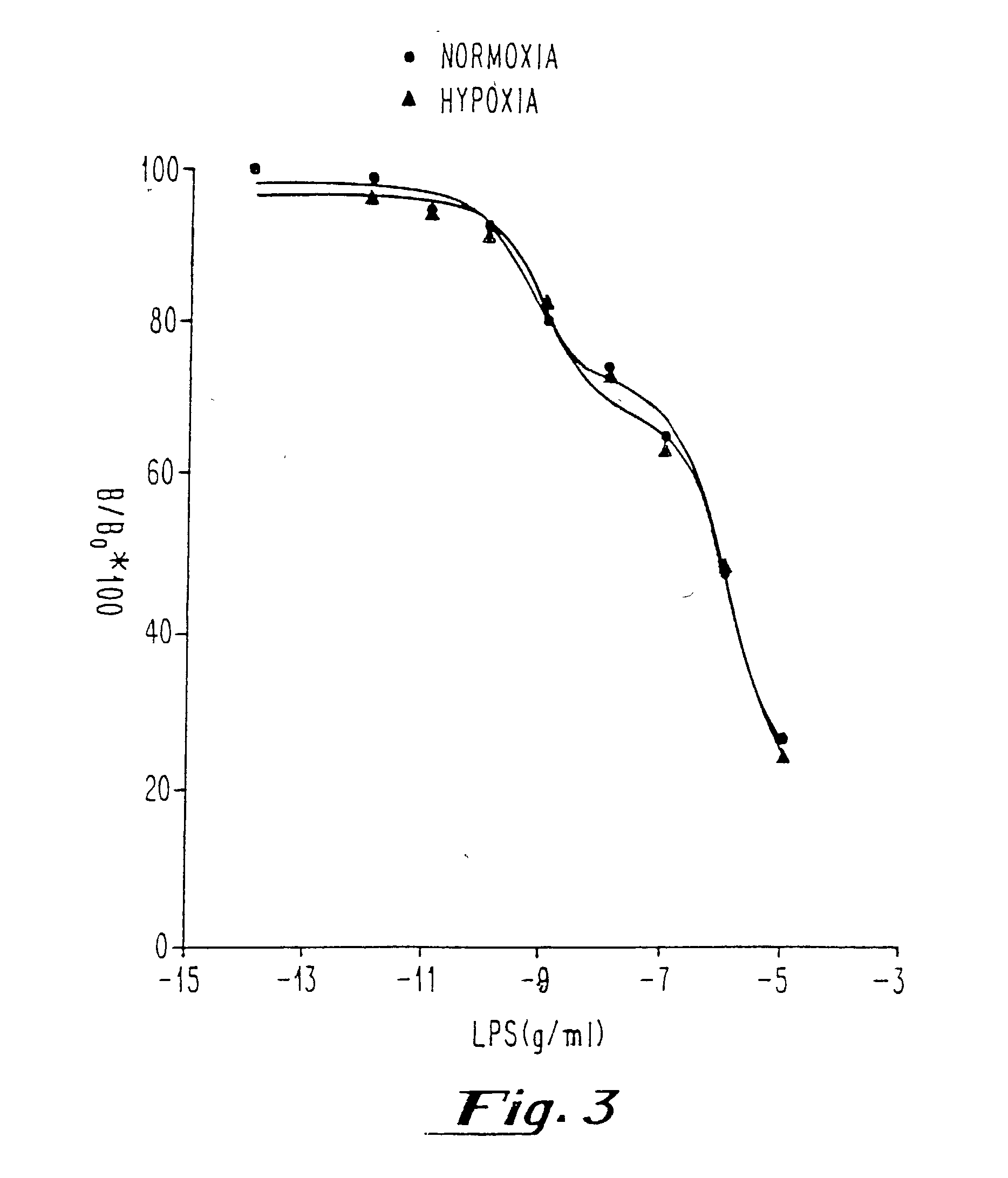Methods and kits for the detection of endotoxi
a technology of endotoxin and kits, which is applied in the field of methods and kits for the detection of endotoxin, can solve the problems of difficult rapid diagnosis at an early stage, irreversible shock and death, organ failure, etc., and achieve the effects of increasing respiratory rate, rapid and accurate diagnosis of septicemia, and increasing heart ra
- Summary
- Abstract
- Description
- Claims
- Application Information
AI Technical Summary
Benefits of technology
Problems solved by technology
Method used
Image
Examples
example 1
Preparation of A.sub.1 Adenosine Receptors for Binding Experiments
[0036] Frozen sheep brain (Pel Freeze, Rodgers, Ark.) or hamster brain (Harlan Bioproducts, Indianapolis, Ind.) was thawed and homogenized in 10 volumes of cold (4.degree. C.), 0.32 M sucrose. The homogenate was centrifuged at 1,000.times. g for 10 minutes to remove the nuclear fraction. The supernatant was centrifuged at 30,000.times. g for 30 minutes. The resulting pellet was resuspended in 10 ml water and left on ice for 30 minutes to obtain synaptosomal membranes. The suspension was then centrifuged at 48,000.times. g for 10 minutes and the membranes resuspended in 50 mM Tris-HCl (pH 7.4) at a concentration of 8 mg protein / ml, frozen in liquid nitrogen, and stored at -20.degree. C. until binding assay.
[0037] Feline PAECs were grown to confluency in 75 mm.sup.2 culture plates. The confluent cells were washed twice with KSP buffer (10 mM KH.sub.2P0.sub.4, 50 mM sucrose). The cells were scraped and suspended in KSP b...
example 2
Saturation Experiments
[0039] Binding of [.sup.3H] DPCPX or [.sup.3H] CCPA to membranes was carried out in an assay volume of 500 .mu.l Tris-HCl, pH 7.4, MgCl.sub.2 (10 mM) (for membranes from feline PAECs only) containing [.sup.3H] DPCPX or [.sup.3H] CCPA (0.01 to 4 nM). Nonspecific binding of [.sup.3H] DPCPX or [.sup.3H] CCPA was determined in the presence of R-PIA (100 .mu.M) or theophylline (1 mM), respectively. To remove endogenous adenosine, adenosine deaminase was present in all binding assays at a concentration of 0.2 U / ml. Incubations were performed for 2 hours at room temperature for sheep and hamster brain membranes and 4.degree. C. for feline PAEC membranes. Incubations were terminated by rapid removal of the incubation buffer by filtration through Whatman GF / B filters (Whatman Inc., Clifton, N.J.). The membrane bound radioactivity was measured by scintillation counting of the filter paper. To determine Kd, Bmax, and nonspecific binding in sheep and hamster brain and feli...
example 3
Competition Experiments
[0040] After determination of the Kd, Bmax and nonspecific binding of [.sup.3H] DPCPX or [.sup.3H] CCPA in membranes prepared from sheep and hamster brains and pulmonary arterial endothelial cells with and without hypoxia, competition experiments with known concentrations of endotoxin [LPS from E. coli 055:B5, E. coli 0111:B4, Serratia marcescens, and Salmonella typhimurium; 0.1 pg / ml-10 .mu.g / ml in saline or plasma) were performed in the presence of [.sup.3H] DPCPX or [.sup.3H] CCPA (0.2-5 nM). Measurements of all samples (saline and plasma) were performed in duplicate.
PUM
| Property | Measurement | Unit |
|---|---|---|
| systolic blood pressure | aaaaa | aaaaa |
| concentrations | aaaaa | aaaaa |
| pH | aaaaa | aaaaa |
Abstract
Description
Claims
Application Information
 Login to View More
Login to View More - R&D
- Intellectual Property
- Life Sciences
- Materials
- Tech Scout
- Unparalleled Data Quality
- Higher Quality Content
- 60% Fewer Hallucinations
Browse by: Latest US Patents, China's latest patents, Technical Efficacy Thesaurus, Application Domain, Technology Topic, Popular Technical Reports.
© 2025 PatSnap. All rights reserved.Legal|Privacy policy|Modern Slavery Act Transparency Statement|Sitemap|About US| Contact US: help@patsnap.com



